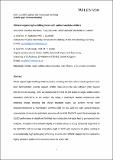Infrared organic light-emitting diodes with carbon nanotube emitters
Abstract
While organic light-emitting diodes (OLEDs) covering all colors of the visible spectrum have been demonstrated, suitable organic emitter materials in the near-infrared (nIR) beyond 800 nm are still lacking. Here, we demonstrate the first OLED based on single-walled carbon nanotubes (SWCNTs) as the emitter. By using a multi-layer stacked architecture with matching charge blocking and charge transport layers, we achieve narrow band electroluminescence at wavelengths between 1000 nm and 1200 nm, with spectral features characteristic of excitonic and trionic emission of the (6,5) SWCNTs used. We investigate the OLED performance in detail and find that local conduction hot-spots lead to pronounced trion emission. Analysis of the emissive dipole orientation shows a strong horizontal alignment of the SWCNTs with an average inclination angle of 12.9° with respect to the plane, leading to an exceptionally high outcoupling efficiency of 49 %. Our SWCNT-based OLEDs represent a highly attractive platform for emission across the entire nIR.
Citation
Graf , A , Murawski , C , Zakharko , Y , Zaumseil , J & Gather , M C 2018 , ' Infrared organic light-emitting diodes with carbon nanotube emitters ' , Advanced Materials , vol. 30 , no. 12 , 1706711 . https://doi.org/10.1002/adma.201706711
Publication
Advanced Materials
Status
Peer reviewed
ISSN
1521-4095Type
Journal article
Description
This research was financially supported by the Volkswagen Foundation (93404), the European Research Council under the European Union's Seventh Framework Programme (FP/2007-2013)/ERC Grant Agreement No. 306298 (EN-LUMINATE) and by EPSRC (EP/R010595/1). C.M. acknowledges funding by the European Commission through a Marie Skłodowska Curie Individual Fellowship (703387). J.Z. thanks the Alfried Krupp von Bohlen und Halbach-Stiftung via the “Alfried Krupp Förderpreis für junge Hochschullehrer” for general support.Collections
Items in the St Andrews Research Repository are protected by copyright, with all rights reserved, unless otherwise indicated.

